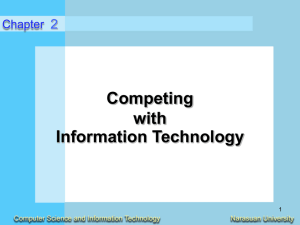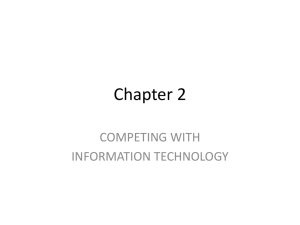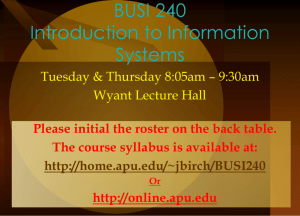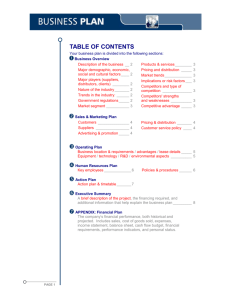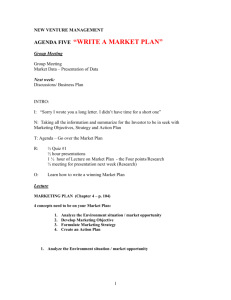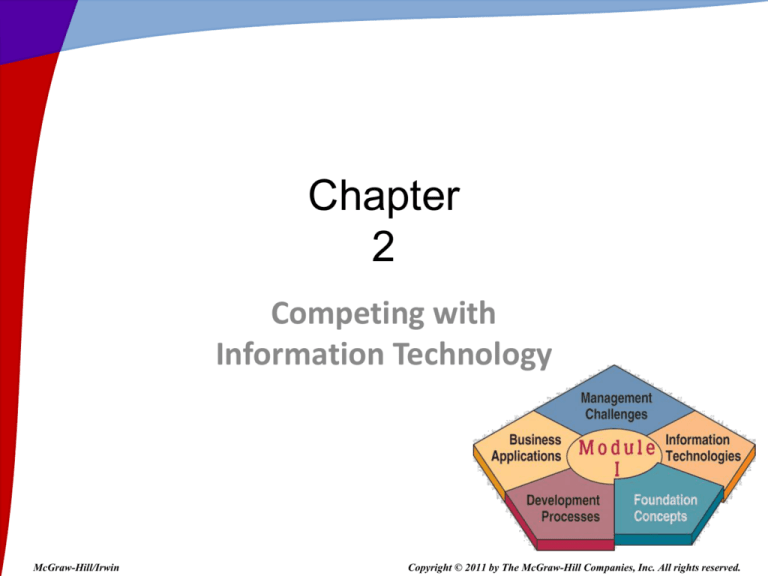
Chapter
2
Competing with
Information Technology
McGraw-Hill/Irwin
Copyright © 2011 by The McGraw-Hill Companies, Inc. All rights reserved.
Learning Objectives
• Identify several basic competitive
strategies and explain how they use
information technologies to confront the
competitive forces faced by a business
• Identify several strategic uses of Internet
technologies and give examples of how
they help a business to gain competitive
advantages
• Give examples of how business process
reengineering frequently involves the
strategic use of IT
2-2
Learning Objectives
• Identify the business value of using
Internet technologies to become an agile
competitor or form a virtual company
• Explain how knowledge management
systems can help a business gain
strategic advantages
2-3
Strategic IT
• Technology is no longer an afterthought in
business strategy, but the cause and driver
• IT can change the way businesses compete
– Vital competitive networks
– Organizational renewal
– Necessary investment
• Integral to success
2-4
Competitive Strategy Concepts
• A strategic information system uses IT to
help an organization…
– Gain a competitive advantage
– Reduce a competitive disadvantage
– Meet other strategic enterprise objectives
• What is Competitive Advantage?
– Capability for advantage over competitive forces
– Leading the industry in some identifiable way
– Sustains profits above the industry average
– Hard to maintain over a long period of time
2-5
RWC 1: Quantify IT Risks and Value
• IT is a business asset, like buildings and land
• Quantify IT Value and Risks
– How much would normal operations cost without
IT systems?
– How much would operations cost if the IT system
goes down?
• IT is investment not cost
• Must align IT with company strategy
2-6
Porter’s Five Forces of Competition
• Rivalry of Competitors
– Positive, natural, healthy
• Threat of new entrants
– Apple, TRS 80, Commodore, IBM, HP,
Compaq, Gateway, Dell, Acer
• Threat of substitutes
– Salon shampoo vs Wal-Mart brand
– VCR vs DVD vs BluRay
• Customer bargaining power
– Buy from competitors or don’t buy
• Suppliers bargaining power
– Your competitor pays in days not weeks
2-7
Competitive Forces and Strategies
2-8
Five Competitive Strategies
• Cost Leadership
– Become low-cost producers
– Help suppliers or customers reduce costs
– Increase cost to competitors
• Example: Priceline
• Differentiation Strategy
– Set a firm’s products apart from competitors’
– Focus on a particular segment or niche market
• Example: Dell
2-9
Competitive Strategies (continued)
• Innovation Strategy
– Unique products, services, or markets
– Radical changes to business processes
• Example: Dell
• Growth Strategy
– Expand company’s capacity to produce
– Expand into global markets
– Diversify into new products or services
• Example: Wal-Mart
2-10
Competitive Strategies (continued)
• Alliance Strategy
– Includes mergers, acquisitions, joint
ventures, virtual companies
– Customers, suppliers, competitors,
consultants, and other companies
• Example: Wal-Mart uses automatic inventory
replenishment by supplier
2-11
Using Competitive Strategies
• Not mutually exclusive
– One alone won’t usually fix the problem
– Generally need a combination
• Innovation not necessarily differentiated
– Kindle v. iPad
– MP3 players vs iPod
– Gateway made in US, relaxed office
• Differentiation not necessarily innovative
– Shipping more efficient but not different
– Telecom companies compete
2-12
Using IT to Implement Basic Strategies
2-13
Implementing Competitive Strategies
2-14
Other IT strategies
2-15
Other Competitive Strategies
• Lock in Customers and Suppliers
– Deter them from switching to competitors
• Create Switching Costs
– Time, money, effort or inconvenience needed
to switch to a competitor
• Raise Barriers to Entry
– Discourage or delay other companies from
entering the market
– Increase the technology or investment
needed to enter
2-16
Other Competitive Strategies
• Build a strong IT department
• Use IT to:
– Take advantage of strategic opportunities
– Improve efficiency of business practices
– Develop products and services that would not
be possible without a strong IT capability
• Use IT to do more than automate a system,
be creative
2-17
Competitive Advantage can become
Competitive Necessity
2-18
Customer-Focused Business
• Keep customers loyal
– Anticipate their future needs
– Respond to customer concerns
– Provide top-quality customer service
• Focus on customer value
– Quality, not price, has become the primary
determinant of value
2-19
Providing Customer Value
• Companies that consistently offer the
best value from the customer’s
perspective…
– Track individual preferences
– Keep up with market trends
– Supply products, services, and information
anytime, anywhere
– Tailor customer services to the individual
– Use Customer Relationship Management
(CRM) systems to focus on the customer
2-20
Building Customer Value via the Internet
2-21
Value Chain and Strategic IS
• Activities that add value
– Primary processes – direct
– Support processes – indirect
2-22
Strategic Uses of IT
• Gain a competitive differentiation
– Products
– Services
– Capabilities
• Somehow do things better
– Just-in-time
2-23
Business Process Reengineering
• Called BRP or simply Reengineering
– Radical
– Seeks improvements
• High potential
• High risk
• Important enabler of reengineering
– IT
– Process teams
– Case managers
2-24
Role of Information Technology
• Major role
– Increase process efficiencies
– Improves communication
– Facilitates collaboration
2-25
RWC 2: Running a Business on Smartphones
• CPS Energy
– Smartphones with digital cameras
– Cut response time
– Reduced inventory
• Lloyd’s Construction
– Smartphones with GPS
– Mobile productivity software
– Low cost
– High return
2-26
BPR Versus Business Improvement
2-27
Cross-Functional Processes
• Reengineered with…
– Enterprise resource planning software
– Web-enabled electronic business and
commerce systems
2-28
Reengineering Order Management
2-29
Strategies for Becoming an Agile Company
• Presents products as solutions to problems
– Can price as a solution not cost to produce
• Cooperates with customers, suppliers and
competitors
– Brings products to market as quickly and costeffectively as possible
• Thrives on change and uncertainty
– Responds to changing customer expectations
• Leverages people and knowledge
– Provides incentives for responsibility,
adaptability, and innovation
2-30
How IT Helps a Company be Agile
2-31
Creating a Virtual Company
• A virtual company uses IT to link…
–
–
–
–
People
Organizations
Assets
Ideas
• Inter-enterprise information systems link…
–
–
–
–
Customers
Suppliers
Subcontractors
Competitors
2-32
A Virtual Company
2-33
Virtual Company Strategies
2-34
Building a Knowledge-Creating Company
• A knowledge-creating company or learning
organization…
– Consistently creates new business knowledge
– Disseminates it throughout the company
– Builds it into its products and services
2-35
Knowledge Management
• Explicit Knowledge
– Data, documents, and things written down or
stored in computers
• Employee handbook
• Tacit Knowledge
– The “how-to” knowledge in workers’ minds
– Most important information
• Successful knowledge management
– Rewards sharing
– Makes better use of knowledge
2-36
Knowledge Management Techniques
2-37
RWC 3: Trading Securities
• Investment companies rely on technology to
gain competitive advantage
• One-second delay can be costly
• Wall Street
– Fewer floor traders
– New alternative exchanges and ecommunications networks
2-38
RWC 4: Reinventing IT
•
•
•
•
•
•
Reliable and excellent IT services
Innovative solutions
Create new products and services
New business models
Lower cost
Highest possible profit margins
2-39


